
Romanesque architecture is an architectural style of medieval Europe that was predominant in the 11th and 12th centuries. The style eventually developed into the Gothic style with the shape of the arches providing a simple distinction: the Romanesque is characterized by semicircular arches, while the Gothic is marked by the pointed arches. The Romanesque emerged nearly simultaneously in multiple countries ; its examples can be found across the continent, making it the first pan-European architectural style since Imperial Roman architecture. Similarly to Gothic, the name of the style was transferred onto the contemporary Romanesque art.
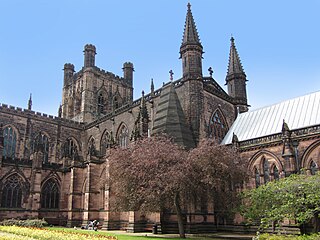
Chester Cathedral is a Church of England cathedral and the mother church of the Diocese of Chester. It is located in the city of Chester, Cheshire, England. The cathedral, formerly the abbey church of a Benedictine monastery dedicated to Saint Werburgh, is dedicated to Christ and the Blessed Virgin Mary. Since 1541, it has been the seat of the Bishop of Chester.

Katarínka are the ruins of a Franciscan monastery and church dating back to the early 17th century, located deep in the forests of the Little Carpathians in western Slovakia, 20 km north of Trnava over Dubovský creek, close to the villages of Dechtice, Naháč and Dobrá Voda. The church was dedicated to Saint Catherine of Alexandria, and that is where the nickname of the place Katarínka comes from.

The Jerónimos Monastery or Hieronymites Monastery is a former monastery of the Order of Saint Jerome near the Tagus river in the parish of Belém, in the Lisbon Municipality, Portugal. It became the necropolis of the Portuguese royal dynasty of Aviz in the 16th century but was secularized on 28 December 1833 by state decree and its ownership transferred to the charitable institution, Real Casa Pia de Lisboa.

Kilcrea Friary is a ruined medieval abbey located near Ovens, County Cork, Ireland. Both the friary and Kilcrea Castle, located in ruin to the west, were built by Observant Franciscans in the mid 15th century under the invitation of Cormac Láidir MacCarthy, Lord of Muskerry, as protection from English troops.

The Grossmünster is a Romanesque-style Protestant church in Zürich, Switzerland. It is one of the four major churches in the city. Its congregation forms part of the Evangelical Reformed Church of the Canton of Zürich. The core of the present building near the banks of the Limmat was constructed on the site of a Carolingian church, which was, according to legend, originally commissioned by Charlemagne. Construction of the present structure commenced around 1100 and it was inaugurated around 1220.

The Church and Friary of St Francis, known locally as Gorton Monastery, is a Grade II* listed former Franciscan friary in Gorton, Manchester, England. It was designed by the noted Victorian architect Edward Welby Pugin and built 1866–1872. Gorton Monastery is a noted example of Gothic Revival architecture.
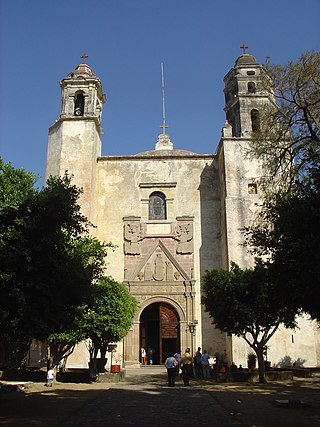
The Earliest Monasteries on the Slopes of Popocatepetl are sixteen earliest 16th-century monasteries which were built by the Augustinians, the Franciscans and the Dominicans in order to evangelize the areas south and east of the Popocatépetl volcano in central Mexico. These monasteries were recognized by the UNESCO as World Heritage Sites in 1994, because they served as the model for the early monastery and church buildings as well as evangelization efforts in New Spain and some points beyond in Latin America. These monasteries almost uniformly feature a very large atrium in front of a single nave church with a capilla abierta or open chapel. The atrium functioned as the meeting point between the indigenous peoples and the missionary friars, with mass for the newly converted held outdoors instead of within the church. This arrangement can be found repeated in other areas of Mexico as these friars continued to branch out over New Spain.

Portuguese Gothic architecture is the architectural style prevalent in Portugal in the Late Middle Ages. As in other parts of Europe, Gothic style slowly replaced Romanesque architecture in the period between the late 12th and the 13th century. Between the late 15th and early 16th century, Gothic was replaced by Renaissance architecture through an intermediate style called Manueline.

The Sophienkirche was a church in Dresden.

The buildings known as Whitefriars are the surviving fragments of a Carmelite friary founded in 1342 in Coventry, England. All that remains are the eastern cloister walk, a postern gateway in Much Park Street and the foundations of the friary church. It was initially home to a friary until the dissolution of the monasteries. During the 16th century it was owned by John Hales and served as King Henry VIII School, Coventry, before the school moved to St John's Hospital, Coventry. It was home to a workhouse during the 19th century. The buildings are currently used by Herbert Art Gallery and Museum, Coventry.
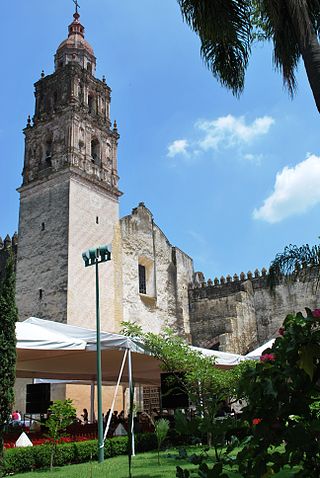
The Cuernavaca Cathedral is the Roman Catholic church of the Diocese of Cuernavaca, located in the city of Cuernavaca, Morelos, Mexico. The church and its surrounding monastery is one of the early 16th century monasteries in the vicinity of the Popocatepetl volcano inscribed as a World Heritage Site by UNESCO, built initially for evangelization efforts of indigenous people after the Spanish conquest of the Aztec Empire. By the 18th century, the church of the monastery began to function as the parish church of the city and in the late 19th century, it was elevated to the rank of a cathedral. Unlike many cathedrals in Mexico, this one does not face the city's main square, but rather is located just to the south, in its own walled compound, which it shares with a number of other structures. Unlike the other monastery structures from its time, the importance of this church provoked a number of renovation projects, the last of which occurred in 1957. This one took out the remaining older decorations of the interior and replaced them with simple modern ones. This renovation work also uncovered a 17th-century mural that covers 400 square metres (4,300 sq ft) of the interior walls and narrates the story of Philip of Jesus and twenty three other missionaries who were crucified in Japan.

The Abbey Church, also known as Nykøbing Church, in Nykøbing on the Danish island of Falster is a church in the Gothic style from the 15th century. Its origins go back to 1419 when Eric of Pomerania, king of the Nordic Kalmar Union, established a Franciscan monastery. One of its treasures is the Mecklenburg Ancestral Table (1627) presenting the ancestors of the dowager Queen Sophie.
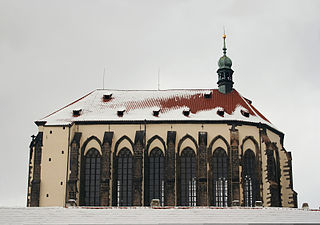
The Church of Our Lady of the Snows is a Catholic church established in 1347 near Jungmann Square in Prague, Czech Republic. It is operated by the Franciscans and was the site of the murders of the Martyrs of Prague in 1611.

The Franciscan Friary, Bolzano is a Franciscan friary in the city of Bolzano, in South Tyrol, northern Italy. It was founded in 1221, less than a century after Bolzano was refounded as a trading centre on the important Brenner route connecting the March of Verona and Italy with the Holy Roman Empire north of The Alps.

The Romanesque style of architecture was introduced in Portugal between the end of the 11th and the beginning of the 12th century. In general, Portuguese cathedrals have a heavy, fortress-like appearance, with crenellations and few decorative elements apart from portals and windows. Portuguese Romanesque cathedrals were later extensively modified, among others the Old Cathedral of Coimbra, although it only had some minor changes.

Ardfert Abbey, also known as Ardfert Friary, is a ruined medieval Franciscan friary and National Monument in Ardfert, County Kerry, Ireland. It is thought to be built on the site of an early Christian monastic site founded by Brendan the Navigator. The present remains date from the mid-thirteenth century, with the residential tower being added in the 15th century. The friary was dissolved in 1584.
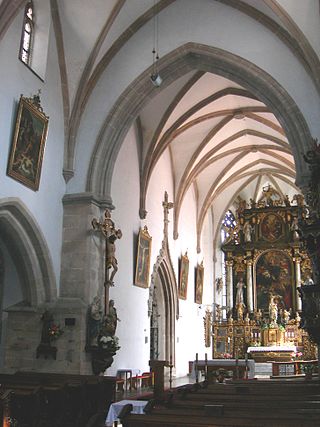
The Franciscan Monastery is located near the Main Square in Plzeň, Czech Republic. Originally belonging to the Minorites, the later Franciscan monastery was founded at the end of the 13th century. The Church of the Assumption of the Virgin Mary, Chapterhouse and Chapel of St. Barbara also belong to the monastery complex.
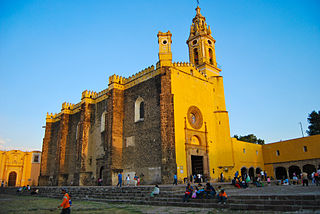
The San Gabriel Franciscan Convent or San Gabriel Friary is a church and friary in Cholula, Metropolitan area of Puebla City, Mexico.
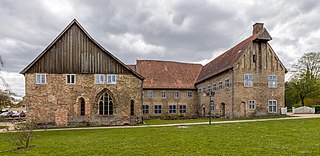
The Graukloster, also known as Kloster St. Paul or Kloster St. Paulus, is a former Franciscan monastery located in Schleswig, Germany. It is named after the gray color of the Franciscan uniform. Following the dissolution of the monastery in 1528/29, the convent buildings were transformed into a shelter for the poor (Armenstift), while the church came under the ownership of the town and was converted into a town hall. The present-day classicistic town hall was built on the foundation walls in 1794/95. Some sections of the medieval convent buildings still remain intact and have been utilized by the city administration since the 1980s.





















